THE SCREENING ROOM

A year-by-year, film-by-film history of 70-millimeter wide gauge exhibition in Southern California
Compiled by Michael Coate and William Kallay
70mm Equipped Theatre Pictures
CINEDOME
Theatre Specifications:
Chains:
Syufy /
Century
Opened:
June 17, 1969
Expanded: November 7, 1974 (3-Plex); November
13, 1974 (4-Plex); June 29, 1977 (6-Plex); November 21, 1986
(8-Plex); February 19, 1992 (11-Plex)
Closed:
February
1999 — Demolished in April 2000
Seats: 863 (in each large domed
auditorium)
Cinedome was a grand, pompous and fun movie theatre, and after 30 years of operation and numerous crowds, the theatre was closed in 1999. For myself, it was the epitome of movie theatres during the modern cinema age.
The Cinedome “20” opened on June 17, 1969, and the Cinedome “21” opened the day after. One of the most unique theatres around the county, the Cinedome was actually similar to various domed theatres built by Syufy in Northern California, the first of which were built in San Jose in the early-1960s. Located off Interstate 5 on Chapman Avenue, the original twin houses were convenient for most people living in Orange County.
Each dome featured stadium seating for 863 patrons, 70mm projection, six-track stereophonic sound, giant curved screens and curtains. The domes themselves were tall and wide, with a design that made the ceiling seem like it went into infinity. You could enter the domes from one of two entrances. Once inside the dome, you could choose various sections of the house to sit down.
The floors were hollow, lending to a relative “cheapness” to this otherwise luxurious theatre. But this added to the Cinedome’s charm. The seats were comfortable and reclined. These were a far cry from the firm and non-reclining seats of today’s theatres. It was like the difference sitting in your grandpa’s old recliner, to sitting on your girlfriend’s modern, "hip" chair. The theatre might not have been the nicest to look at, but it was admittedly comfortable. The screen, once the curtains parted in the days of showmanship here, seemed very large. Curved, it lent a sense of scale to even the littlest of films.
Curtains adorned the screen for many 70mm presentations, and entry music from various films played as you walked into either one of the domes. It wasn’t until the 1980s when slide advertisements and open curtains changed the way the place felt. On some shows, the slides would be turned off, then the curtains would close, then opened for the feature presentation.
The Cinedome was a place of showmanship for years, despite a number of cut-rate elements in its design and customer service. Because of the sheer number of customers on any given weekend night, the staff apparently popped popcorn and put it inside of huge plastic bags. The customer service at Cinedome was usually decent, though most of the staff didn’t seem too willing to help you out. The restrooms, located directly behind the domes, weren’t impervious to sound bleeding through from the theatre. But it was the charm of the Cinedome which kept people coming back. Big, somewhat gaudy, this theatre was a moviegoer’s theatre and made no excuses about it. It was proud to be a big comfy Cadillac in a sea of Camrys.
Many 70mm prints played here, and sometimes, the Cinedome would get two prints of the same film. Popular movies like “Return Of The Jedi” and the last two “Indiana Jones” films would be played on two screens in 70mm. That’s how popular this theatre was. And it wouldn’t be uncommon for four movies to be playing in 70mm at the same time.
Almost every 70mm print that was available to the Los Angeles and Orange County markets played at the Cinedome. With few exceptions, like 70mm prints only reserved for Los Angeles or prints that went to competing theatres like MainPlace, or for oddball distribution 70mm releases like “Rocky III,” the Cinedome got almost every one.
Syufy added screens over the years to this complex, eventually
topping out at eleven screens. The first screen addition
opened on November 7, 1974, and another screen opened on November 13
of the same year. By the late-1980s, the Cinedome expanded to
eight
screens.
Cinedome had a lot of fans, including customers and former
employees. One former customer wrote this site's William Kallay to
thank him for writing up about the theatres. They had a special
place in her heart because she and her husband used to go to
Cinedome a lot. We also received a few emails from former employees
of Cinedome. One employee said the theatre was "always" known as just
"Cinedome." Locals called it the "Orange Cinedome" or "The
Cinedome." No matter. It was the spot to
see movies, despite the correct way to call it. We refer to it as
the Orange Cinedome to clarify it from other Cinedome theatres
around California and Nevada.
Employees also spoke about the fact that the projection booths for
the main domes, in particular, weren't air conditioned and were
outrageously hot during the summer. And apparently projectionists
had to essentially walk on the theater roof to get to the other
booths in the complex.
The company consistently kept the theatre upgraded with the latest in sight and sound and interior design elements. It was never run down, it seemed, even to a year before the theatre was suddenly closed in 1999. For customers, it was still a very nice theatre complex, despite the fact that gang members started to hang around the Cinedome during the 1990s.
Without much fanfare, the Cinedome closed, equipment hauled away and movie memories left inside of people’s memories. During the massive conversion of the exhibition industry to megaplex theatres in the mid-1990s, the Cinedome was suddenly considered old and out-of-date. Syufy, (eventually called Century Theaters), opened a 25-screen theatre on the site on their own Stadium Drive-In on Katella Avenue, just a few miles away from the Cinedome. AMC opened their 30-screen complex on the site of the old City Mall on the other side of Interstate-5, also nearby the Cinedome.
Apparently, the owner of another theatre chain, Captain Blood's, wanted to keep the Cinedome open for his growing chain. But it didn’t happen. The complex stood empty for over a year until April 2000, when bulldozers came in and tore everything down. I snuck into the domes prior to this to take one last look, perhaps risking life and limb. The main dome ("21") in which I saw a number of 70mm presentations was already half-demolished. But the other dome was still intact, except for the seats had been removed. The dome was huge.
It was sad to see that the screen was ripped down and pieces of it were lying in water on the concrete floor. The giant speakers had been removed, but the scaffolding was intact. That screen now seemed much smaller than I remembered it.
I snuck over to the other former 70mm house, a long, yet large rectangular house that was added to the Cinedome in the 1970s. This theatre was hit and miss. The screen was cropped, so sometimes ‘scope films were masked correctly on it, sometimes not. Even films in 1.85:1 could take on wider proportions. And if there was a 70mm print of a more popular movie playing in the dome, or even a popular 35mm film playing in one of the big domes, brand new 70mm prints would find their way into this auditorium. Despite this being my least favorite house in the complex, it was sad to see the screen ripped down and holes in the ceiling.
I took one last look at the theatre from my vantage point on the Santa Ana bike trail nearby. What got to me was not only the fact that this popular theatre was being torn down, but how far movie exhibition had declined in utter showmanship. Even though other theatres that played 70mm in Orange County had closed by 2000, the Cinedome seemed like the theatre that would weather the changes. But it was not to be.
For a lot of people, theatres like the Chinese in Hollywood and the Roxy in New York City, for instance, are the crown jewels of movie exhibition. But for myself, the Cinedome, though not perfect, was an ideal place to see movies, no matter their size or shape. Certainly, I didn’t see every 70mm presentation at this theater complex. I’m glad I tried other theatres for the experience of seeing films there. Yet, in my mind, Cinedome represented everything that was fun and exciting about going to the movies.
It’s hard to believe, but there isn’t a trace of the Cinedome as you
drive past Chapman on I-5. Developers are built a huge
luxury apartment complex on the site. It’s almost as if the theatre
never existed.
Syufy/Century is in the business of movies, but I
think they did an injustice to moviegoers when they closed, then
finally demolished this complex. The newer complexes built nearby,
the Century 25 and AMC 30 At The Block, are a far cry from the
Cinedome. They have no showmanship, personality, or charm. The Cinedome had a personality; these new theatres
don’t.
Orange County lost a major part of its cinema soul when the Cinedome
closed. It lost even more when it was torn down.
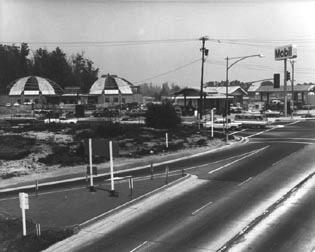 [1] [1] |
| Syufy Orange Cinedome under construction (c. 1969) |
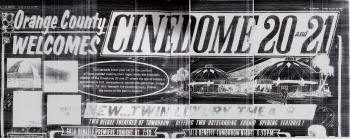 [2] [2] |
| Orange Cinedome grand opening ad (June 17, 1969) [a small portion of the actual ad] |
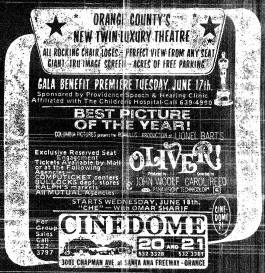 [2] [2] |
| Orange Cinedome grand opening ad for "Oliver!" |
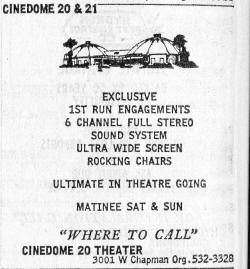 [3] [3] |
| Yellow Pages ad (1971) |
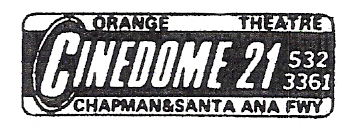 [2] [2] |
| Orange Cinedome logo used in The Orange County Register |
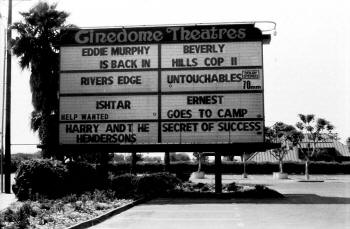 [4] [4] |
| The marquee (1987) |
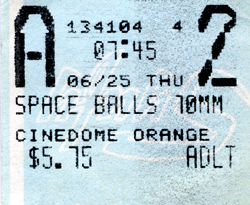 [4] [4] |
| Ticket stub for opening night of Mel Brooks' "Spaceballs" in 70mm (1987) [Enlarge] |
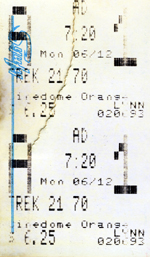 [4] [4] |
| Ticket stub for the horrendous "Star Trek V: The Final Frontier" in 70mm (1989) [Enlarge] |
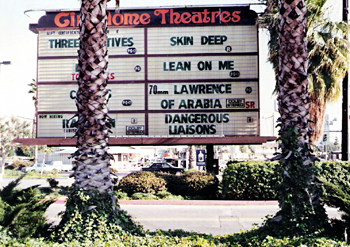 [4] [4] |
| Orange Cinedome marquee (1989) |
 [4] [4] |
| Close-up of marquee promoting 1989 re-issue of "Lawrence Of Arabia" |
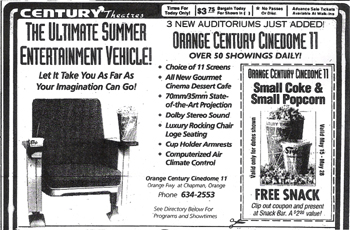 [5] [5] |
| A slick ad for the 1992 expansion to 11-screens (May 15, 1992; actual expansion opened in February 1992) [Enlarge] |
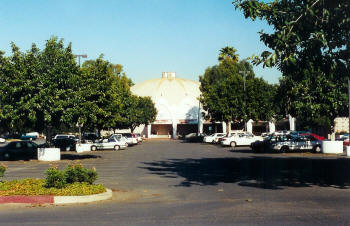 [4] [4] |
| Orange Cinedome (c. 1994) |
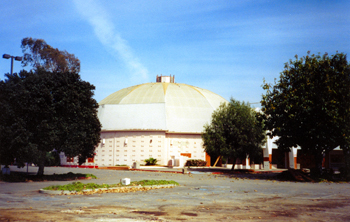 [4] [4] |
| Orange Cinedome "20" shortly after closing in 1999 |
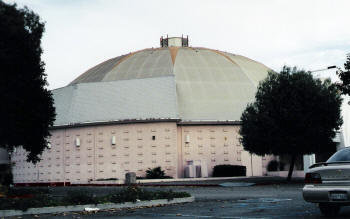 [4] [4] |
| Orange Cinedome "20" |
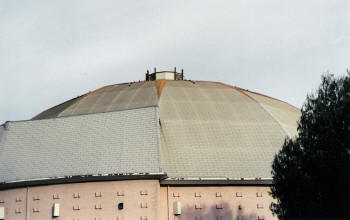 [4] [4] |
| Dome in detail - The domes didn't always look this bad |
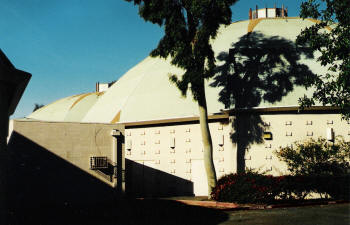 [4] [4] |
| Orange Cinedome "20" (left) and Cinedome "21" (right) |
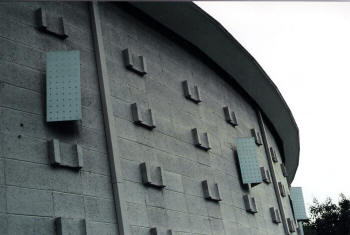 [4] [4] |
| Orange Cinedome "20" screen wall detail |
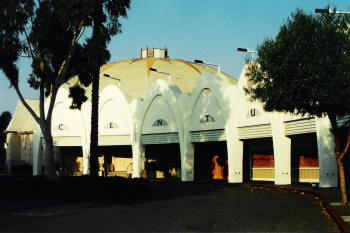 [4] [4] |
| Orange Cinedome box office area |
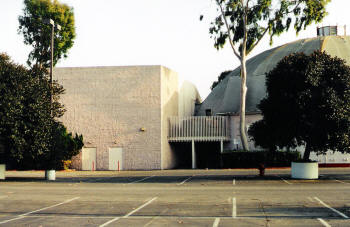 [4] [4] |
| Orange Cinedome, "standard" auditorium (left) |
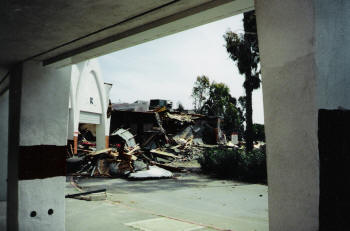 [4] [4] |
| Box office demolition (2000) |
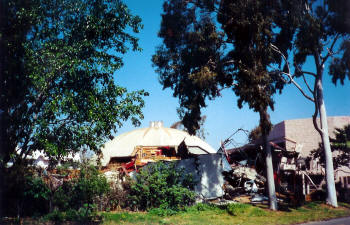 [4] [4] |
| Demolition continues |
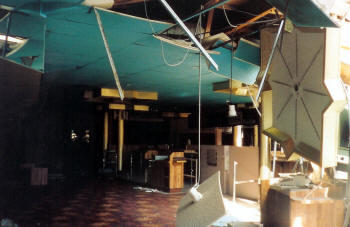 [4] [4] |
| Demolition of the lobby |
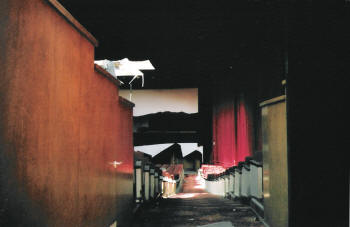 [4] [4] |
| "Standard" auditorium as seen from doorway leading into it |
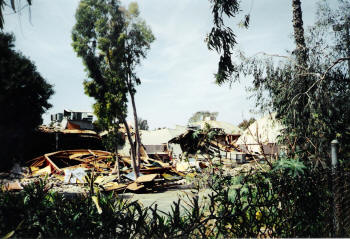 [4] [4] |
| Orange Cinedome nearly demolished |
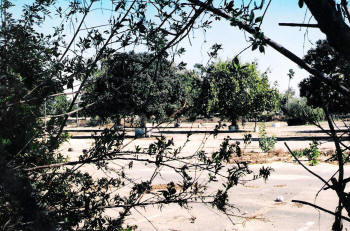 [4] [4] |
| Facing the former Cinedome Theatres (2004) |
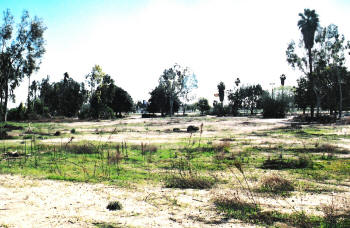 [4] [4] |
| Facing Chapman Avenue |
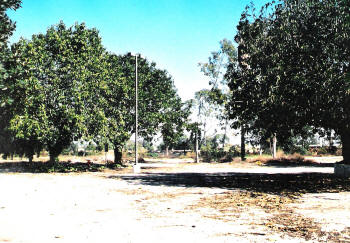 [4] [4] |
| Approximately where the box office and lobby were located |
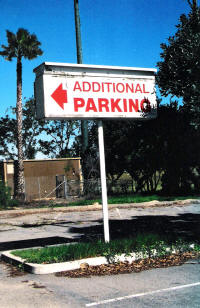 [4] [4] |
| The last remnant of the Orange Cinedome |
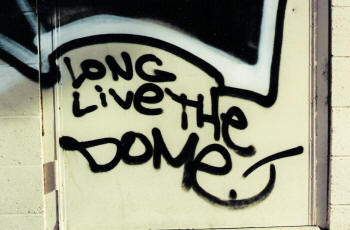 [4] [4] |
| Orange Cinedome vandalism - FSTDVD certainly doesn't condone vandalism, though we agree with the message |
| [1] City Of Orange |
| [2] The Orange County Register / Syufy |
| [3] Orange County Central and North Yellow Pages Directory (Pacific Bell) / Anaheim Central Library |
| [4] William Kallay |
| [5] Los Angeles Times / Century |
[4] Photos © William Kallay. All rights reserved.
Special thanks to Jane Newell (Anaheim Central Library)
More 70mm
70mm In New York
70mm In
Los Angeles